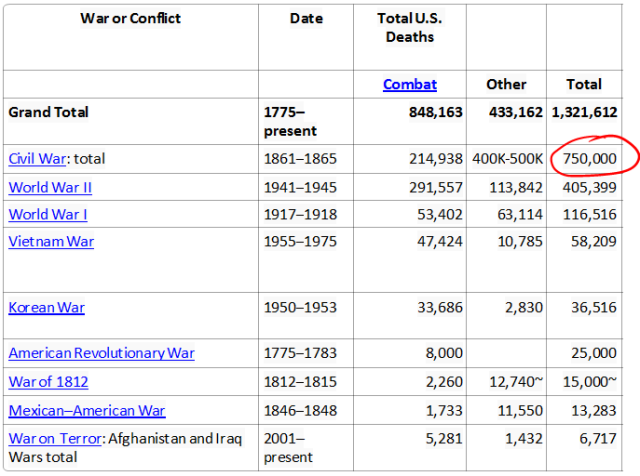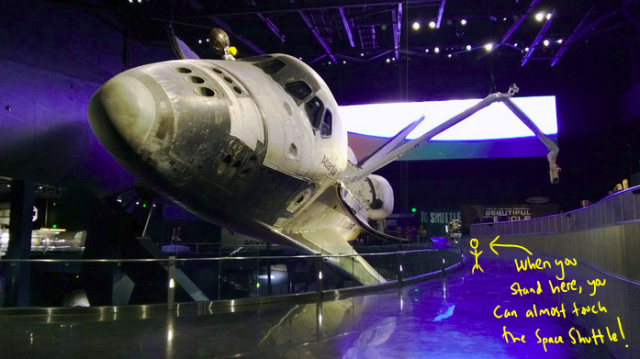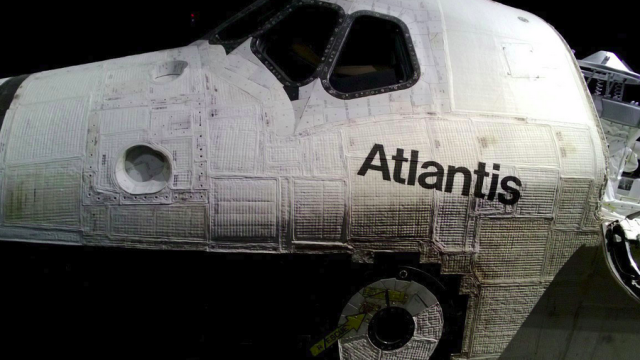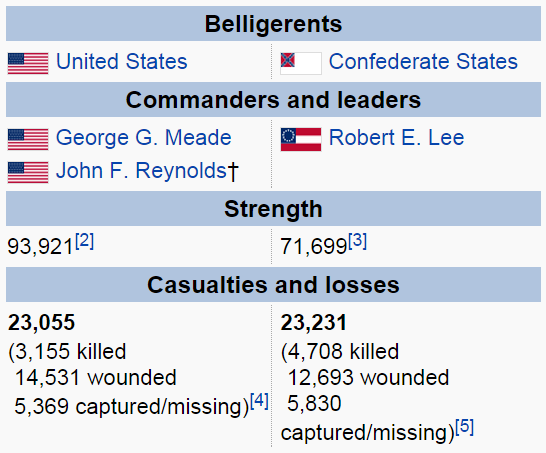My family and I are in South Florida, visiting my father. Thanks to my father’s penchant for technology, we all had a chance to visit the Kennedy Space Center, where we saw the space shuttle Atlantis up close.
As the Kennedy Center website says, “Space Shuttle Atlantis showcases the priceless, historic spacecraft that tells the incredible story of NASA’s 30-year Space Shuttle Program. Space Shuttle Atlantis is displayed as only spacewalking astronauts have seen her before — rotated 43.21 degrees with payload doors open and its Canadarm (robotic arm) extended, as it has just undocked from the International Space Station.”
What was so cool about this exhibit is that visitors first see two short upbeat videos about taking the idea of “making a shuttle that is re-usable,” and following that idea through a 12-year process from idea to actual space shuttle.
The videos, shown on a HUGE screen, end with a picture of Atlantis at an angle (apparently a 43.21 degree angle). At the end of the movie, the screen turns transparent to reveal the actual shuttle behind the screen. Then the screen lifts up, and the group you entered the exhibit with can walk right up to the railing and see the shuttle (and explore the 60 interactive exhibits that surround Atlantis).
So after the movie ends, you literally walk into the scene above. And as my chicken scratching says in yellow above, you can almost touch the shuttle. Up close, the heat shields — which prevent the shuttle from burning up on re-entry into Earth’s atmosphere — look like a quilt of old blankets (see the lower right corner of this picture below).
More pictures of the Atlantis Space Shuttle are on this great June 2013 article from BoingBoing.
My point is that the exhibit at the Kennedy Space Center (KSC) has a great “hook” — it makes you excited about the space program, and then brings to life the Atlantis mission. When the screen comes up, you want to learn as much as possible about the shuttle (though to be fair, you wanted to learn about Space in the first place, or you would not have come to visit the KSC). Having one of the actual space shuttles suspended in mid-air in front of you while you learn about it is extremely cool.
I wonder if there’s some way to bring to life events in US History from the pre-Civil War period in a similar fashion… we’d need to find a compelling question and some neat artifacts. But I’m guessing there’s a way to do it. We’ll work on that the rest of this year, as we explore how the United States grew larger and ultimately split apart in a civil war that lasted 4 years and claimed the lives of 620,000 to 700,000 people.
That’s a lot of people dying.
To put that number in perspective, the US population in 1860 was about 31 million, so 620,000 people represents 2% of the people. The US today has about 320 million people, so losing 2% of today’s population would mean 6.4 million people killed.
As you can see below, more people died in the Civil War than in all other US wars combined (though World War II is a close second):
 source for data: US Military Casulaties of War from Wikipedia.
source for data: US Military Casulaties of War from Wikipedia.
My students did not choose to sign up to take a class in the US Civil War, the way we chose to visit the KSC — but the Civil War is a compelling subject that I’ll work to bring to life for them. The battle at Gettysburg, PA, for example, resulted in nearly 8,000 deaths over the course of three days of fighting (July 1-3, 1863), plus more than 25,000 injured.
Here’s what President Abraham Lincoln had to say when he visited Gettysburg in November of 1863, just four months after the bloody battle. He was there to dedicate a portion of the battlefield as a cemetery. This is one of the most famous (and shortest) speeches in U.S. History. We will read and analyze it soon after we start classes again in January — and then we will work to learn more about events that led up to the civil war in order to put this speech in perspective. Here’s a first look at Honest Abe’s most famous speech:
Four score and seven years ago our fathers brought forth on this continent, a new nation, conceived in Liberty, and dedicated to the proposition that all men are created equal.
Now we are engaged in a great civil war, testing whether that nation, or any nation so conceived and so dedicated, can long endure. We are met on a great battle-field of that war. We have come to dedicate a portion of that field, as a final resting place for those who here gave their lives that that nation might live. It is altogether fitting and proper that we should do this.
But, in a larger sense, we can not dedicate — we can not consecrate — we can not hallow — this ground. The brave men, living and dead, who struggled here, have consecrated it, far above our poor power to add or detract. The world will little note, nor long remember what we say here, but it can never forget what they did here. It is for us the living, rather, to be dedicated here to the unfinished work which they who fought here have thus far so nobly advanced. It is rather for us to be here dedicated to the great task remaining before us — that from these honored dead we take increased devotion to that cause for which they gave the last full measure of devotion — that we here highly resolve that these dead shall not have died in vain — that this nation, under God, shall have a new birth of freedom — and that government of the people, by the people, for the people, shall not perish from the earth.
Abraham Lincoln
November 19, 1863
Source: http://www.abrahamlincolnonline.org/lincoln/speeches/gettysburg.htm




